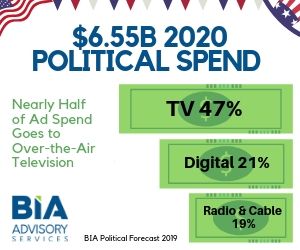Campaigns to Shell Out $6.5B on Local Ads in 2020; 47% for TV
CHANTILLY, VA.—Candidates for office next year will spend $6.55 billion on local political advertising with nearly half being spent on over-the-air television, according to a new estimate from BIA Advisory Service.

BIA is forecasting political spending on OTA TV advertising will reach $3.08 billion, or 47% of the total, followed by online/digital outlets at $1.37 billion (21%), multichannel video programming distributors (MVPDs) at $919 million (14%) and radio at $312 million (4.8%). The rest will go to other media outlets, including direct mail, which normally is a major political advertising medium but will only capture a small percentage in 2020, BIA said.
“Campaigns will continue to rely on television as a dominant platform for advertising while supplementing with digital advertising across mobile and desktop,” said Mark Fratrik, chief economist and SVP at BIA Advisory Services.
Los Angeles, Phoenix and Philadelphia are expected to top media markets in terms of political ad spending next year. In Los Angeles, candidates will spend $168 million on TV, $76 million on digital, $55 million on cable TV and $17 million on radio, according to BIA.
TV spending in Phoenix and Philadelphia will be high with the former seeing $156 million in spending and the latter experiencing a TV ad spend of $135 million, the company said.
“In some of the smaller markets, one thing to keep an eye on is how the huge volume of political advertising could crowd out other local advertisers during primary and general election seasons,” said Fratrik. “That may have an impact on advertisers and media companies, and we’ll certainly factor that into our forecasting as we go through the fall.”
The estimates of 2020 political advertising will be part of BIA ADVantage, an advertising intelligence report focusing on 94 markets.
The professional video industry's #1 source for news, trends and product and tech information. Sign up below.
More information is available on the BIA Advisory Services website.
Phil Kurz is a contributing editor to TV Tech. He has written about TV and video technology for more than 30 years and served as editor of three leading industry magazines. He earned a Bachelor of Journalism and a Master’s Degree in Journalism from the University of Missouri-Columbia School of Journalism.

